RestoringYourFinds
Sr. Member
- Apr 11, 2012
- 292
- 185
- Detector(s) used
- Minelab CTX 3030
XP Deus
- Primary Interest:
- All Treasure Hunting
Speaking of restoring...
Here is a silver spoon that I found in the US. Completely bent (in every direction), folded on itself. After discovering about "quenching" and "annealing", I decided to give it a try. (Using just my kitchen stove... one has to be daring sometimes...) Some people would rather use a small blowtorch for this. Well... I just don't have one. And honestly, the kitchen stove flame proved to be efficient enough. Silver reacts differently than iron. When you heat iron and then put it into water, it makes it harder and stronger. It's just the opposite with silver. You heat it, then put it in the water, and it makes it soft enough to be worked on. To get the spoon bowl back... I used a wooden spoon I basically only used wood items to work on my spoon. Also, do not forget to use pliers or anything that would help holding the spoon as you heat it. (needless to say, I know) Be careful not to use tools that have metal handles since the heat will be transferred to those. Quenching (if I remember correctly) is heating and putting directly into cold water. Annealing is the last process when you heat it but let it get cool by itself. THAT makes it stronger and stabilizes its new shape. Because during the process, silver can get a little darker (and red stained if you don't pay enough attention and over heat it), I cleaned it by wrapping it up in aluminum foil with baking soda and placed it in boiling water for a few minutes.
I basically only used wood items to work on my spoon. Also, do not forget to use pliers or anything that would help holding the spoon as you heat it. (needless to say, I know) Be careful not to use tools that have metal handles since the heat will be transferred to those. Quenching (if I remember correctly) is heating and putting directly into cold water. Annealing is the last process when you heat it but let it get cool by itself. THAT makes it stronger and stabilizes its new shape. Because during the process, silver can get a little darker (and red stained if you don't pay enough attention and over heat it), I cleaned it by wrapping it up in aluminum foil with baking soda and placed it in boiling water for a few minutes.
Maker is J&I Cox (NYC, 1817-1852) and the spoon bears the initials "AM".
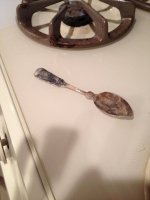
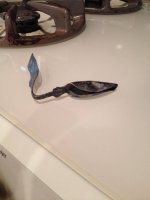
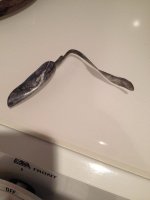
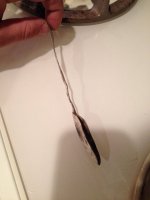
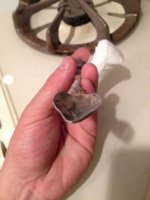
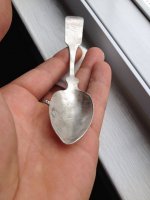
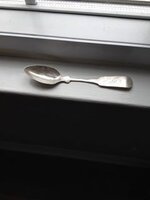
This video is not perfect but it gives you an idea of the overall process :
Here is a silver spoon that I found in the US. Completely bent (in every direction), folded on itself. After discovering about "quenching" and "annealing", I decided to give it a try. (Using just my kitchen stove... one has to be daring sometimes...) Some people would rather use a small blowtorch for this. Well... I just don't have one. And honestly, the kitchen stove flame proved to be efficient enough. Silver reacts differently than iron. When you heat iron and then put it into water, it makes it harder and stronger. It's just the opposite with silver. You heat it, then put it in the water, and it makes it soft enough to be worked on. To get the spoon bowl back... I used a wooden spoon
 I basically only used wood items to work on my spoon. Also, do not forget to use pliers or anything that would help holding the spoon as you heat it. (needless to say, I know) Be careful not to use tools that have metal handles since the heat will be transferred to those. Quenching (if I remember correctly) is heating and putting directly into cold water. Annealing is the last process when you heat it but let it get cool by itself. THAT makes it stronger and stabilizes its new shape. Because during the process, silver can get a little darker (and red stained if you don't pay enough attention and over heat it), I cleaned it by wrapping it up in aluminum foil with baking soda and placed it in boiling water for a few minutes.
I basically only used wood items to work on my spoon. Also, do not forget to use pliers or anything that would help holding the spoon as you heat it. (needless to say, I know) Be careful not to use tools that have metal handles since the heat will be transferred to those. Quenching (if I remember correctly) is heating and putting directly into cold water. Annealing is the last process when you heat it but let it get cool by itself. THAT makes it stronger and stabilizes its new shape. Because during the process, silver can get a little darker (and red stained if you don't pay enough attention and over heat it), I cleaned it by wrapping it up in aluminum foil with baking soda and placed it in boiling water for a few minutes.Maker is J&I Cox (NYC, 1817-1852) and the spoon bears the initials "AM".







This video is not perfect but it gives you an idea of the overall process :
Upvote
0



